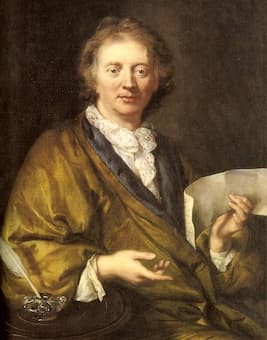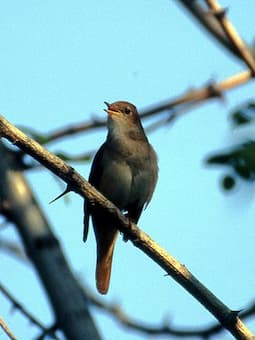
Anonymous: François Couperin (Chateau de Versailles)
French Baroque composer François Couperin (1668–1733), who had a career as a composer, harpsichordist, and organist in the French royal court, was born into a famous family of Parisian musicians. He served in the court of Louis XIV as organiste du roi (organist of the king) and was raised to the nobility in 1696. He wrote in a wide range of genres including choral music, secular vocal music, chamber music, and many works for harpsichord. To differentiate him from the other members of the extensive Couperin family, he was known as Couperin le Grand (Couperin the Great).
Some of his harpsichord music was written to be played with other instruments and we find this piece in his third book of harpsichord pieces, a work about ‘the nightingale in love.’ This was published in his Third Book of Pieces for the Harpsichord, published in 1722. The four volumes of harpsichord pieces are important because they indicate where ornaments should be played, and what ornaments should be played where, an innovation for the time. Most harpsichord publications relied on the player to supply his own ornaments at his own discretion. These harpsichord works carry evocative titles, such as ‘The Enchantress,’ ‘Happy Ideas,’ or, as in this case, ‘The Nightingale in Love.’

Common Nightingale (male)
The Nightingale is a small plain bird in the flycatcher family. It is known for its powerful and beautiful song, and its name comes from that: the ‘gale’ in Nightingale comes from the Old English word ‘galan,’ to sing. They sing both at night and during the day and it is that exception night singing that so many musicians have captured in their music. Poets from Homer onward also bring the nightingale into their works.
The work has two parts – first the simple version of the work and the work ‘doubled,’ i.e., with ornaments applied. This happens at 01:47 and one of the effects is that the sound of the bird seems to emerge more clearly. The work is one where the nightingale seems to be introspective, with a gentle side to its song.
François Couperin: Pieces de clavecin, Book 3 – 14th Ordre in D Major-Minor – Le rossignol-en-amour (Shin-ichiro Nakano, harpsichord)
At the end of the piece, Couperin inserted two brief comments one on taste and one on style. The first says ‘One should not focus too precisely on the measure in the Double … everything must be sacrificed to taste.’ The other is a note that the piece would also work well on the transverse flute (not a recorder) but only ‘when it is well played.’
François Couperin: Pieces de clavecin, Book 3 – 14th Ordre in D Major-Minor – Le rossignol-en-amour (arr. for flute) (Jed Wentz, flute)
With the harpsichord as accompaniment, the flute has a stronger base upon which to build its ornaments.
François Couperin: Pieces de clavecin, Book 3: 14th Ordre in D Major-Minor: Le rossignol-en-amour (arr. for flute and harpsichord) (Jean-Pierre Rampal, flute; Michio Kobayashi, harpsichord)
Despite Couperin specifying that a transverse flute, i.e., a regular flute, recorder players have been fond of taking up this work.
François Couperin: Pieces de clavecin, Book 3: 14th Ordre in D Major-Minor (arr. for recorder and harpsichord): Le rossignol-an-amour (Michala Petri, recorder; Hanne Petri, harpsichord)
There are also versions for 2 flutes, for flute and harp, oboe, and an arrangements made by anyone who wants to play the introspective musings of this centuries-old symbol of love.
For more of the best in classical music, sign up to our E-Newsletter

